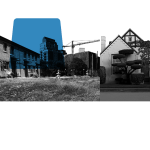Alameda County is an epicenter of the gentrification and displacement crisis rocking the Bay Area. Skyrocketing housing costs and deepening socioeconomic inequities have led to mass displacement of poor families. Forced to move to the edges of the Bay Area, working-class families are struggling to find quality jobs and schools, decent housing and public transportation, social services, and neighborhoods that are environmentally safe and healthy.
But the families who stay in Alameda County are struggling, too. They can’t afford rising rents and other necessities, so they move into overcrowded housing, relocate constantly, or lose their homes completely.
As an agency committed to addressing the social determinants of health and advancing social justice, the Alameda County Public Health Department (ACPHD) strives to understand not just how housing insecurity contributes to poor health and inequities but how gentrification creates cycles of housing instability.
Though the housing crisis is a familiar one, the public health lens offers a different way of understanding its impacts.
Several key findings from our analyses of the regional housing crisis raise serious public health concerns. In one survey, 355 staff from county programs in public health and behavioral health care indicated that displacement and rising rents were exacerbating health risks, as well as undermining the agencies’ ability to provide services effectively.
Our epidemiological analysis also showed a high correlation between housing stressors (severe rent burden and overcrowding) and key health indicators, such as mental health emergency department visits, asthma-related emergency department visits, and hypertension hospitalization rates. Data for Oakland and Alameda County showed that as the percentage of residents using 50% or more of their income on rent increases, so does the rate of hypertension-related hospitalizations.
As the percentage of residents using 50% or more of their income on rent increases, so does the rate of hospitalizations for severe mental disorders.
And as the percentage of residents living in overcrowded conditions increases, the rate of asthma-related emergency department visits increases more than fourfold.
Though the housing crisis is a familiar one, the public health lens offers a different way of understanding its impacts. Current conditions are creating a foundation for poor health outcomes for the residents of our region. These outcomes may last generations.
Public agencies at multiple levels — including local planning departments, redevelopment agencies, economic development agencies, and public health departments — have played an important role in past “urban renewal” initiatives that helped drive disinvestment of low-income neighborhoods. These efforts are followed by the profit-driven remaking of these neighborhoods to benefit private developers, corporations, and wealthier residents. This relationship was highlighted in our report with Causa Justa::Just Cause, Development without Displacement: Resisting Gentrification in the Bay Area.
So, for poor and working-class families to stay in urban centers — where they have historical and cultural roots as well as social supports and services — without compromising their health, they must first have affordable and healthy homes.
This principle undergirds our work on baseline tenant protections: rent stabilization, just cause eviction laws, and policies that prevent unregulated rent hikes, illegal evictions, and landlord harassment of tenants.[1] These efforts, along with the production and preservation of truly affordable housing, form the front line of defense for communities being dismantled by gentrification and displacement.
In a local health department, diverse and frequently siloed programs, such as nutrition services and tobacco control, all address housing issues without necessarily knowing what their sister programs are doing.
Local health departments have an important role to play to protect tenants and defend communities against gentrification. Our practice centers on 3 main strategies:
1) We emphasize the link between policy and direct service outcomes.
Working on both policy and direct services requires developing staff capacity and creating an organizational culture that supports the institutionalization of cross-programmatic work to address the housing crisis.
Ongoing conversations between our direct services staff and our policy unit help develop a shared analysis and understanding of housing issues grounded in client experiences. In a local health department, diverse and frequently siloed programs, such as nutrition services and tobacco control, all address housing issues without necessarily knowing what their sister programs are doing. Using client experiences to guide collaboration, program staff may uncover opportunities to coordinate services or policy change efforts.
For example, staff working with clients in Asthma Start, Family Health Services, and Healthcare for the Homeless shape our housing policy agenda through their knowledge of residents’ perspectives. They also contribute to policy analysis and implementation through participation in work groups with community partners.
Indeed, it was a caseworker from Asthma Start who helped the policy unit prioritize code enforcement reform in our housing agenda. Visiting the homes of children diagnosed with asthma throughout Alameda County, she often came across severe mold, leaks, old carpets, rats, and other housing conditions that undermined any doctors’ visits and medications.
The caseworker tried to help tenants request repairs, but she encountered many problems, including the backlash in the form of rent increases or eviction threats. She took her issue to ACPHD’s policy unit, which led to our pushing the City of Oakland to consider proactive code enforcement. Today, ACPHD participates in the Healthy Homes Partnership with the code enforcement department.
2) We work closely with neighborhoods, community-organizing groups, advocacy groups, and governmental partners.
Our housing practice began with a partnership with a grassroots community organization, Causa Justa::Just Cause, which asked ACPHD to intervene in a local public health crisis. Tenants were dealing with utilities shutoffs while living in foreclosed, bank-owned properties, and abandoned properties were exacerbating neighborhood blight.
We produced a report, Rebuilding Neighborhoods, Restoring Health, that combined participatory research with epidemiology and local data analysis to assess the impacts of foreclosure in Oakland’s hardest-hit neighborhoods. The community-driven efforts led to a policy to prevent utilities from shutting off water to tenants in bank-owned properties as well as a city registration for vacant properties that resulted in more than $1 million in fines collected from banks and investors.
We continue to work on rental housing quality, affordability, and stability with policy advocates, city agencies, and community members.
3) We communicate directly with decisionmakers to address the causes of health inequities.
Through a robust community engagement process, we developed a housing policy platform and agenda that identified and analyzed the causes of housing inequities and how they shape health. This analysis led us to prioritize policy work to improve the code enforcement system and ensure housing funds are used for those with the greatest housing need.
For public health practitioners, preventing displacement and ensuring access to affordable and safe housing may be the single greatest challenge and the most important task in our collective efforts to create healthy communities for all.
[1] Urban Displacement Project
Tram Quang Nguyen coordinates economic and housing policy work with the Place Matters initiative of Alameda County Public Health Department (ACPHD).

